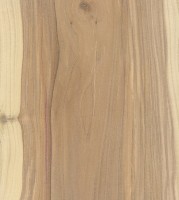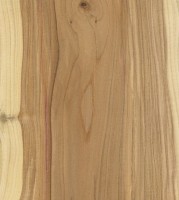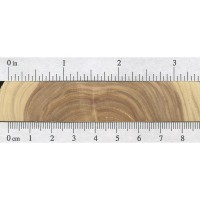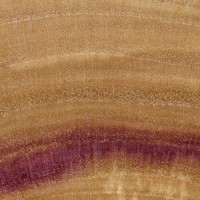 |
Common Name(s): Lilac Scientific Name: Syringa spp. (Syringa vulgaris) Distribution: Native to Europe and Asia; cultivated in many temperate areas worldwide Tree Size: 6-25 ft (2-8 m) tall, 4-8 in (10-20 cm) trunk diameter Average Dried Weight: 59 lbs/ft3 (945 kg/m3) Specific Gravity (Basic, 12% MC): .74, .95 Janka Hardness: 2,350 lbf (10,440 N)* *Estimated hardness based on specific gravity Modulus of Rupture: No data available Elastic Modulus: No data available Crushing Strength: No data available Shrinkage: Tangential shrinkage is in excess of 10%; reported to have a high level of shrinkage |
Color/Appearance: Colors can be variable depending on species. Sometimes seen with reddish or lavender color streaks throughout the heartwood.
Grain/Texture: Slightly interlocked grain, with a very fine texture. Good natural luster.
Endgrain: Semi-ring-porous; small to medium earlywood pores and small latewood pores, very numerous; pores can sometimes be exclusively solitary, or a mix of solitary and radial multiples of 2-3; growth rings usually distinct; narrow rays not visible without lens, spacing fairly close; parenchyma absent.
Rot Resistance: No official reports available.
Workability: Reported to be an excellent turning wood. Tends to distort and develop end-checks during drying.
Odor: Lilac has a distinct, floral scent when being worked.
Allergies/Toxicity: Besides the standard health risks associated with any type of wood dust, no further health reactions have been associated with Lilac. See the articles Wood Allergies and Toxicity and Wood Dust Safety for more information.
Pricing/Availability: Due to its small size (typically only a shrub or bush), Lilac is not considered a woodworking lumber, and is never commercially harvested. Small pieces may be occasionally available from through hobbyist and other small-scale channels.
Sustainability: This wood species is not listed in the CITES Appendices or on the IUCN Red List of Threatened Species.
Common Uses: Occasionally used for small turned projects such as pens and bowls, as well as carved items.
Comments: In the Oleaceae family, Lilac bears at least a distant relation to Olive. Not to be confused with Chinaberry, which is an unrelated species that is sometimes referred to as “Persian Lilac.”
None available.





A pen from lilac wood
Has anyone tried to make a flute from a lilac stick? Normally I only make walking sticks (not tried lilac yet – but just found a local source) and wanted to try something different.
I made a shillelagh inspired cane from lilac.
I made an excellent walking stick from lilac. If you have a dying bush it is an easy thing to do with all the little trunks.
I used an old lilac root to make a phone stand. On the outer edges the wood is white, 3-4 centemeters deep was all red. Great smell. Added an oil finish, otherwise the wood quickly loses its color from oxidation or the sun rays. Only one crack from drying. The wood is mostly easy to work with.
Here is a cutting board from lilac. The wood is extremely hard and I didn’t have to plane. The table saw blade polished it.
Lilac has such a nice look. Sweet board Mr Samuelson. Do you use your Lilac cutting board daily & how’s it holding up?
Greetings to all wood lovers, I would like to show you a few pieces of lilac and what I made of it. I really like it, it’s hard heavy wood and a little bit lottery drying and cracking. Lilac I really love for his beauty and nice smell in grinding and cutting. Lilac 4-8 in (10-20 cm) trunk diameter is a smaller size them in Europe. Here is bigger, we have 20 to 25 cm diameter i personaly own one log 31cm diameter and i see rare bigger. I like to give more photos, but more them 4 do not… Read more »
Looks good. You can always just create another comment and attach more photos that way. I think the limit is just four photos per comment.
Maple bridge (for archtop guitar) with a lilac top.
Beautiful! I take it you’re using the lilac as a substitute for e.g. ebony?
indeed (i do not use any tropical woods in my instruments)
Good to know it can serve as a replacement for such a hard tropical wood! I may still have some pieces of sizeable lilac trunc from the specimen we cut down last year; how long would you say it needs to dry before it can be used for this kind of purpose?
I’d say to dry it for as long as possible – many years – and to progressively re-saw it every year or so. I have some that’s dried over perhaps 25 years. It moves a LOT when it’s drying and I’m not sure whether to cut it, split it, or leave it whole. The grain is far too twisted for successful splitting, but if you just saw it you get pieces with grain that goes in every direction. I tried all three methods and none was successful. Every time I thought they were stable they’d split or move some more,… Read more »
Thanks, I feared that much :)
I have made coasters from Lilac Wood and it has dried for over 20 years. Some of the original wood is 4-7 inches in diameter, I covered them in wax and paint and let them dry naturally, covered. Some split and cracked. Some didn’t. I am going to have access soon, to some that is larger than these that are still alive. It takes about a year per inch in thickness , at my humidity, to dry wood. I’ll almost be 90 when it gets dry…but ya gotta try it.
BTW, that’s an interesting saddle design, not limiting string spacing by the adjustment posts!
how does polishing with laquer work on this wood , oris there any special treatment required
hi was wondering , how good is this wood for making furniture and whats the normal seasoning or drying process
My (very limited) experience with Lilac is that it seldom gets big enough to use for things like furniture, but if you do manage to get pieces big enough, you should probably be very intentional about how you design the furniture. In my experience, Lilac is pretty unstable and will shrink and warp a lot as it dries — I’m not sure if that also translates to being unstable once dried, but it should at least be taken into account.
Would this be a safe wood for hamsters to chew on? Like, does it have any oils in it or anything?
I have gathered root balls of lilac, both live and burned over by fire. Turning the wood green is a real pleasure, the root balls are made up of lignotubers, which are essentially very small burls about 1/4″ or so in diameter, packed together to make up the root ball. After the wood is dry, it is extremely hard, and is very difficult to turn. Sharp tools or carbide tools take off very small shavings, about .001″ thick in most cases. Because of the fine structure of the lignotubers, the wood is very tough. When the root balls are found… Read more »
Can it be used as firewood, just worried about it being poisonous
We burn it all the time, and have never had any difficulty, or would have any reason to suspect that there would be any. The wood is not poisonous that I know of, and haven’t caused me any problems when turning, except that the water/sap in the wood is very deep red, and gets on your hands and clothes. Washes out though.
Any advice on drying? The high winds that drove the terrible forest fires here in Oregon blew over part of my neighbor’s lilac tree. He have me the blown over parts which included several 6” thick sections of 18” or longer. The heartwood is purple and intact – which is rare (here in Western Oregon it seems the heartwood almost always rots away on older trees). I immediately cut the trunk section into 18” logs and dipped each end into paraffin. I left the bark on. The rootball I almost completely covered in wax. Was this the right way to… Read more »
Lilac often grows in twisted forms, and tends to split when dried. Yours may have already split due to the intense heat.
best to split or cut along the central pith to separate log halves, and even split these into quarters, if you can work with such small pieces. Would be excellent for small turning projects like a chess set.
How long does it typically take to dry?
Honestly, I think I had better luck actually stripping the bark (including cambium) off the greenwood. But I must concur that lilac has a STRONG tendency to split!
It has a VERY pleasant heft and would serve well in making canes, batons and other defensive items.
So is lilac considered a hardwood or softwood?
It’s a hardwood.
Thank you very much!